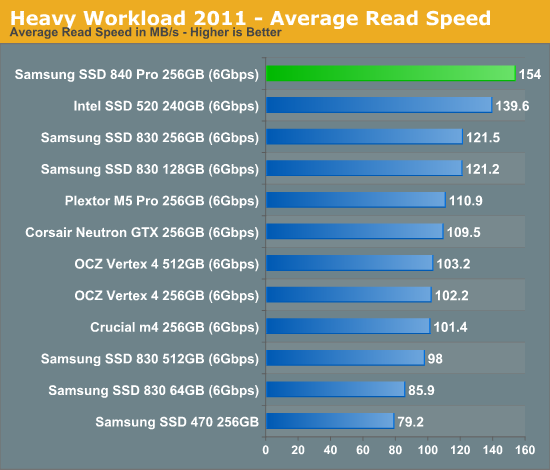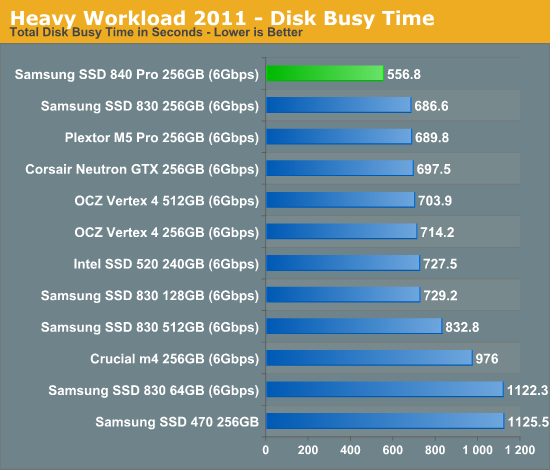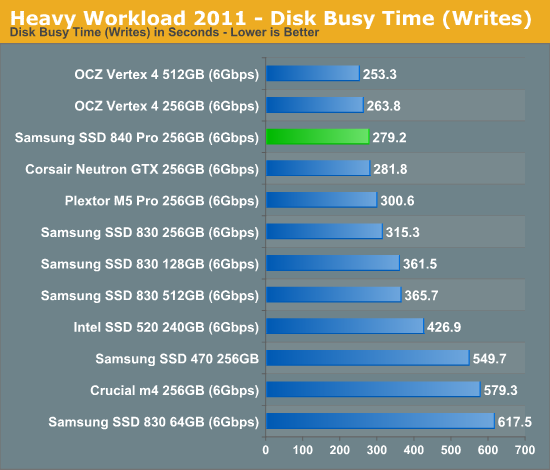Samsung SSD 840 Pro (256GB) Review
by Anand Lal Shimpi on September 24, 2012 7:00 AM EST- Posted in
- Storage
- SSDs
- Samsung
- Samsung SSD 840
AnandTech Storage Bench 2011
Two years ago we introduced our AnandTech Storage Bench, a suite of benchmarks that took traces of real OS/application usage and played them back in a repeatable manner. I assembled the traces myself out of frustration with the majority of what we have today in terms of SSD benchmarks.
Although the AnandTech Storage Bench tests did a good job of characterizing SSD performance, they weren't stressful enough. All of the tests performed less than 10GB of reads/writes and typically involved only 4GB of writes specifically. That's not even enough exceed the spare area on most SSDs. Most canned SSD benchmarks don't even come close to writing a single gigabyte of data, but that doesn't mean that simply writing 4GB is acceptable.
Originally I kept the benchmarks short enough that they wouldn't be a burden to run (~30 minutes) but long enough that they were representative of what a power user might do with their system.
Not too long ago I tweeted that I had created what I referred to as the Mother of All SSD Benchmarks (MOASB). Rather than only writing 4GB of data to the drive, this benchmark writes 106.32GB. It's the load you'd put on a drive after nearly two weeks of constant usage. And it takes a *long* time to run.
1) The MOASB, officially called AnandTech Storage Bench 2011 - Heavy Workload, mainly focuses on the times when your I/O activity is the highest. There is a lot of downloading and application installing that happens during the course of this test. My thinking was that it's during application installs, file copies, downloading and multitasking with all of this that you can really notice performance differences between drives.
2) I tried to cover as many bases as possible with the software I incorporated into this test. There's a lot of photo editing in Photoshop, HTML editing in Dreamweaver, web browsing, game playing/level loading (Starcraft II & WoW are both a part of the test) as well as general use stuff (application installing, virus scanning). I included a large amount of email downloading, document creation and editing as well. To top it all off I even use Visual Studio 2008 to build Chromium during the test.
The test has 2,168,893 read operations and 1,783,447 write operations. The IO breakdown is as follows:
| AnandTech Storage Bench 2011 - Heavy Workload IO Breakdown | ||||
| IO Size | % of Total | |||
| 4KB | 28% | |||
| 16KB | 10% | |||
| 32KB | 10% | |||
| 64KB | 4% | |||
Only 42% of all operations are sequential, the rest range from pseudo to fully random (with most falling in the pseudo-random category). Average queue depth is 4.625 IOs, with 59% of operations taking place in an IO queue of 1.
Many of you have asked for a better way to really characterize performance. Simply looking at IOPS doesn't really say much. As a result I'm going to be presenting Storage Bench 2011 data in a slightly different way. We'll have performance represented as Average MB/s, with higher numbers being better. At the same time I'll be reporting how long the SSD was busy while running this test. These disk busy graphs will show you exactly how much time was shaved off by using a faster drive vs. a slower one during the course of this test. Finally, I will also break out performance into reads, writes and combined. The reason I do this is to help balance out the fact that this test is unusually write intensive, which can often hide the benefits of a drive with good read performance.
There's also a new light workload for 2011. This is a far more reasonable, typical every day use case benchmark. Lots of web browsing, photo editing (but with a greater focus on photo consumption), video playback as well as some application installs and gaming. This test isn't nearly as write intensive as the MOASB but it's still multiple times more write intensive than what we were running in 2010.
As always I don't believe that these two benchmarks alone are enough to characterize the performance of a drive, but hopefully along with the rest of our tests they will help provide a better idea.
The testbed for Storage Bench 2011 has changed as well. We're now using a Sandy Bridge platform with full 6Gbps support for these tests.
AnandTech Storage Bench 2011 - Heavy Workload
We'll start out by looking at average data rate throughout our new heavy workload test:

A strong showing in all of our low level IO tests, with no drawbacks, results in 24% better performance than the 830 in our heavy workload. There's simply no faster drive than the 840 Pro.


The next three charts just represent the same data, but in a different manner. Instead of looking at average data rate, we're looking at how long the disk was busy for during this entire test. Note that disk busy time excludes any and all idles, this is just how long the SSD was busy doing something:













96 Comments
View All Comments
KPOM - Monday, September 24, 2012 - link
This looks like a nice SSD from Samsung offering top tier performance combined with low power consumption.nathanddrews - Monday, September 24, 2012 - link
Agreed. I love my Samsung 830 drives, so at least now I know where to go when I upgrade!Old_Fogie_Late_Bloomer - Monday, September 24, 2012 - link
I came THIS close to buying an 830 yesterday for my laptop. I even did a search for "Samsung 840" to see if there was any news of a successor, to no avail. Still, something stopped me from doing it, and it looks like my procrastination paid off...HisDivineOrder - Monday, September 24, 2012 - link
Exact same thing happened to me. Think the sales were just a little too good lately. Made me suspicious.Old_Fogie_Late_Bloomer - Monday, September 24, 2012 - link
Ha ha, come to think of it, I know exactly what you mean. And not that the 256GB 830 isn't a good deal at $200, but I think the improvements in the 840 Pro will be worth it.I wish I could justify the cost of a 500/512GB drive, but I can always throw my laptop's original HD in a hard drive caddy if I need more storage.
Grok42 - Monday, September 24, 2012 - link
Same here. I kept seeing the 830 show up in sales but couldn't find any rumors about a next generation drive. I've been putting off my new build for a while now. Prior to waiting on the 840 I waited for the next Nvidia release which ended up being the 660TI. I get everyone worry about a new SSD drive but by the time I actually pull the trigger on everything it will have been out a month and I'll know by then.TrackSmart - Monday, September 24, 2012 - link
If you can get the 830 at a massive discount, why not go for it? A couple of thoughts:1) I would never put a new-to-market SSD in on of my machines. It's not worth the risk. Check back in 6 months, or a year, and see how they have held up.
2) There's no discernible difference in performance among any of the top-tier SSDs under normal workloads. Anand and company make these drives jump through flaming hoops (i.e. their Bench suite) before they see differences between the drives under normal workloads.
I'd rather buy something that is fast, proven reliable, and at a good price. I'll let others be the crash test dummies for new SSDs.
Old_Fogie_Late_Bloomer - Monday, September 24, 2012 - link
Yeah, I thought about that, too. Why not go for a cheaper, proven drive that's nearly as fast? On the other hand, I bought a 320 based on its reputation for reliability, and a month later, bam, 8MB power bug, so you really never know.In my case, my laptop is not a mission-critical device; I have a desktop, as well as access to other laptops in the house, so if it suddenly needs service, it's not the end of the world. It's on me to do regular backups, and the 840 Pro has a FIVE YEAR warranty. So I think maybe I will be the crash test dummy this time, for the heck of it. Worst case scenario, I can always just toss the original hard drive back in there.
peterfares - Monday, September 24, 2012 - link
The thing is, you're not going to ever notice the difference between the 830 and the 840, or even the Crucial M4. I've seen the 256GB Crucial M4 for as low as $140 in the past couple weeks. That is a much better purchase than the 840 if the 256GB 840 is any more then $180 or so.Old_Fogie_Late_Bloomer - Monday, September 24, 2012 - link
Back when I got my Intel 320 SSD, I bought it because of Intel's reputation for reliability. Then they went with Sandforce controllers and I just don't trust them anymore. Meanwhile, Samsung also developed a reputation for reliability, and I'm inclined (perhaps unfairly) to trust them over other manufacturers.I'll be curious to see what Samsung and Anand have to say about the failure of the unit used for this review. I could still see going for the 830 if there's an indication that reliability HAS been compromised in some way.